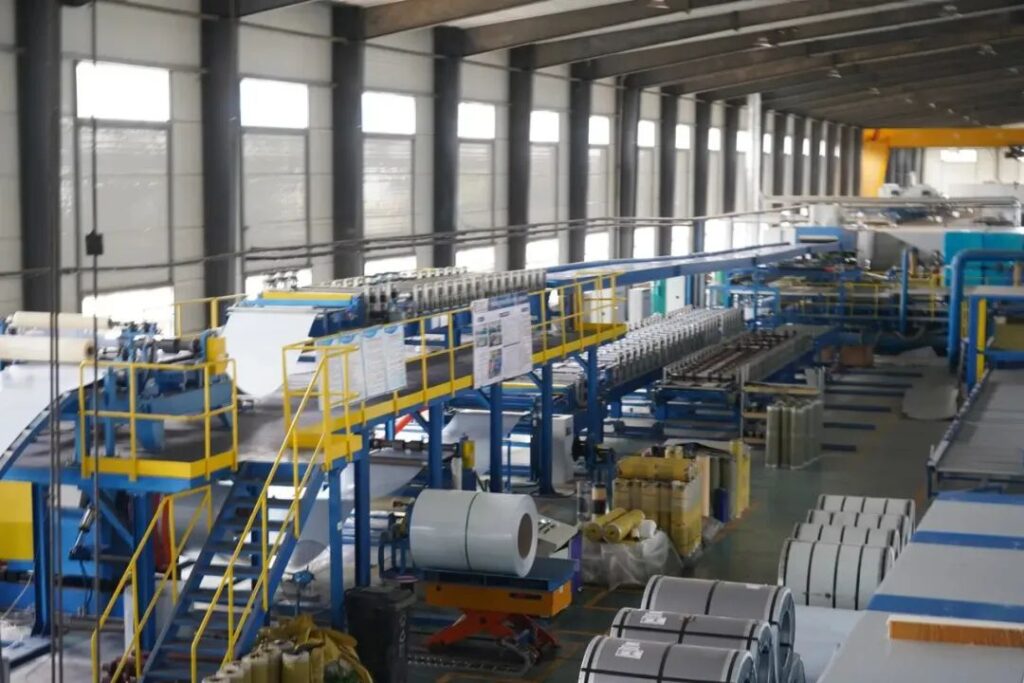
Currently, in the cold chain industry, polyurethane insulation boards can be divided into two types based on the manufacturing method: continuous polyurethane insulation boards and regular handmade insulation boards.
As the name suggests, handmade boards are produced manually. This involves folding the color-coated steel plate edges with a machine, then manually installing the surrounding keel, applying glue, filling the core material, and pressing it to form the final product.
Continuous boards, on the other hand, are made by continuously pressing the color steel sandwich panels. On a specialized production line, the color-coated steel plate edges and the core material are bonded and cut to size in one go, resulting in the finished product.
Handmade boards are more traditional, while continuous boards have gradually emerged in recent years.
Next, let’s take a look at the polyurethane insulation boards produced by the continuous line.
1.Production Process
Our production process incorporates high-quality polyurethane foaming equipment and a fully automated continuous board production line. This production line features a user-friendly interface that simplifies operation and monitoring. Advanced computer controls make it easy to adjust parameters across the entire line, ensuring stable and rapid operation.
Not only does the production line boast excellent performance, but it also demonstrates an extreme attention to quality in every detail. The design fully considers the various needs of actual production, ensuring high efficiency while significantly reducing operational difficulty. Additionally, the production line features a high level of automation and intelligence, minimizing human interference and enhancing the consistency and reliability of the products.
The general process of the polyurethane continuous board production line includes the following steps:
- Automatic uncoiling
- Film coating and cutting
- Forming
- Film lamination at the interface roller path
- Preheating the board
- Foaming
- Double-belt curing
- Band saw cutting
- Rapid roller path
- Cooling
- Automatic stacking
- Final product packaging

2. Production Process Details
The forming area consists of upper and lower roll forming equipment along with a quick-change mechanism. This setup allows for the production of various board shapes to meet diverse customer needs.
The foaming area is equipped with a high-pressure polyurethane foaming machine, a pouring machine, and a double-belt laminator. These ensure that the boards are uniformly foamed, densely packed, and firmly bonded.
The band saw cutting area includes a tracking saw and an edge milling machine, which are used for precise cutting of the boards to the required dimensions.
The stacking and packaging area is comprised of rapid conveyor rollers, an automatic flipping system, stacking, and packaging systems. These components handle tasks such as transporting, flipping, moving, and packaging the boards.
This entire production line enhances efficiency by completing tasks like board transport, flipping, movement, and packaging. The packaging system ensures that the products are well-protected during production and transportation, maintaining superior performance and stable quality. The production line has been widely applied and highly praised for its effectiveness.
3.Advantages of Continuous Line Insulation Boards
1 )Quality Control
Manufacturers of insulation boards invest in automated production lines and use high-pressure foaming systems. Typically, a pentane-based polyurethane foaming system is used, which ensures uniform foaming with a closed-cell rate consistently above 90%. This results in controllable quality, uniform density at all measurement points, and excellent fire resistance and thermal insulation.
2)Flexible Dimensions
Compared to handmade boards, the production of continuous boards is more flexible. Handmade boards are limited by their production method and cannot be produced in larger sizes. Continuous boards, however, can be customized to any size according to customer requirements, with no size limitations.
3)Increased Production Capacity
The polyurethane continuous production line is fully automated, with integrated board forming and no need for manual intervention. This allows for 24-hour continuous operation, strong production capacity, short production cycles, and fast shipping times.
4)Ease of Use
Continuous polyurethane boards use a tongue-and-groove structure for interlocking connections. The connections are reinforced with rivets at both the top and bottom ends, making assembly convenient and reducing the time required for cold storage construction. The tight connection between the boards ensures high airtightness at the seams, minimizing the likelihood of deformation over time.
5 )Superior Performance
The overall performance of pentane-based polyurethane continuous boards is stable, with a fire resistance rating of up to B1. They offer excellent thermal insulation and surpass national standards, meeting the needs of various cold storage users.




